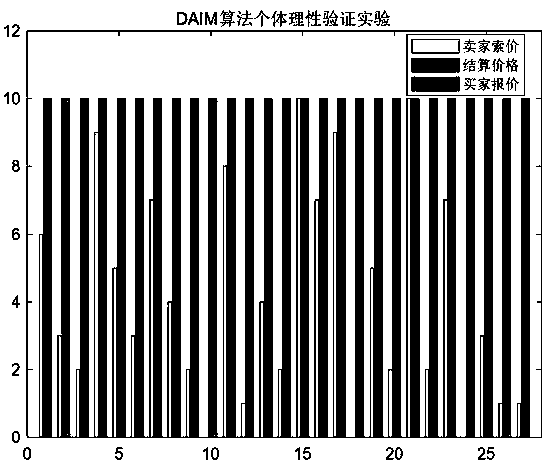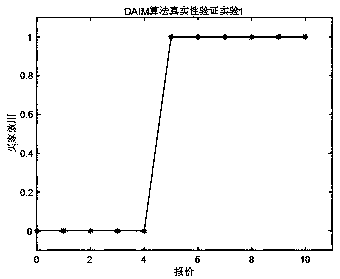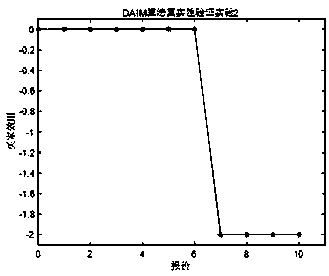Two-way auction-based method of mobile group intelligence perception and resource allocation and incentive mechanism thereof
A mobile crowd-sensing and resource allocation technology, applied in the field of mobile crowd-sensing based on two-way auction and its resource allocation and incentive mechanism, can solve the problems of incompetence, low-end configuration and performance, etc.
- Summary
- Abstract
- Description
- Claims
- Application Information
AI Technical Summary
Problems solved by technology
Method used
Image
Examples
Embodiment 1
[0081] Example 1: In order to verify the computational effectiveness of the DAIM algorithm, according to the number of people set in Table 1, each group randomly generated 100 instances, and averaged the computing time of these 100 instances to ensure the reliability of the results sex. The test experiment of computing effectiveness is carried out on Windows10 system, the processor is Core TM i7-6650UCPU@2.20GHz2.21GHz, RAM is 16.0GB. The experimental settings and results are shown in the table below.
[0082]
[0083] The steps of the experiment are as follows: firstly, the number of buyers n is fixed at 50, the number of sellers m is changed from 50 to 400, and the number of sellers is increased by 50, and the DAIM algorithm is run, in which each group of records randomly generates 100 experiments, and records the 100 times. The average running time of the first experiment; after that, fix the number of sellers m to 50, change the number of buyers n from 50 to 400, and ...
Embodiment 2
[0084] Example 2: In order to verify the individual rationality of the DAIM algorithm, run the DAIM algorithm under the same hardware configuration environment as the above-mentioned calculation effectiveness, the specific settings are 100 sellers and 25 buyers, and analyze the successful pairing between buyers and sellers The relationship between the seller's asking price, the buyer's settlement price and the buyer's quotation. From attached figure 1 It can be seen from the figure that for each buyer in DAIM, the settlement price with the auctioneer will not be higher than his bid price, and each winning seller will get paid no less than his asking price from the auctioneer. price. Therefore, the DAIM algorithm satisfies individual rationality. The results of individual rationality show that when the resources of the smart device itself are not rich enough, when it is necessary to request higher computing performance or higher completion quality from the resource supply par...
Embodiment 3
[0086] Example 3: In order to verify the authenticity of the DAIM algorithm, randomly select buyers and sellers among randomly generated buyers and sellers, and observe the changes in buyer / seller utility caused by changes in the buyer's quotation / seller's asking price, as shown in the attached Figure 2 to Figure 5 As shown, both the buyer and the seller meet the nature of authenticity. Divide the experiment into 4 sub-experiments, and conduct experimental research and analysis on the utility changes of winning buyers, non-winning buyers, winning sellers, and non-winning sellers respectively. The settings and configuration of the experiment are the same as the above-mentioned individual rational experiment, and the authenticity research of the DAIM algorithm is conducted for 100 sellers and 25 buyers.
PUM
 Login to View More
Login to View More Abstract
Description
Claims
Application Information
 Login to View More
Login to View More - R&D
- Intellectual Property
- Life Sciences
- Materials
- Tech Scout
- Unparalleled Data Quality
- Higher Quality Content
- 60% Fewer Hallucinations
Browse by: Latest US Patents, China's latest patents, Technical Efficacy Thesaurus, Application Domain, Technology Topic, Popular Technical Reports.
© 2025 PatSnap. All rights reserved.Legal|Privacy policy|Modern Slavery Act Transparency Statement|Sitemap|About US| Contact US: help@patsnap.com



